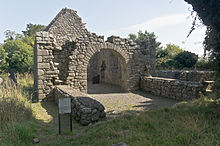Tully Church



Tully Church is an ancient church in County Dublin, Ireland.[2][3][4][5]
Location
Tully Church lies in Laughanstown (Irish: Baile an Locháin; variously spelled Lehaunestown, Lehaunstown); it is located in Dún Laoghaire–Rathdown, 500 m south-southeast of Laughanstown Luas stop.
Following redevelopment of the surrounding area, the church, its graveyard and the nearby high cross were incorporated into the 9-hectare Tully Park which opened in May 2023.[6]
The building
The original church structure dates to the 6th–9th centuries AD. One ancient name is Telach-na-nun ecspop (Tullow of the bishops) and it must have been an important venue if bishops met there. There is a legend that seven bishops started out from there to visit St Brigid at Kildare. Elsewhere these bishops are mentioned as the "Seven Bishops of Cabinteely" (Alice Curtayne, Saint Brigid of Ireland)[citation needed]
In 1179 the Church was granted to the Priory of The Holy Spirit.[citation needed]
The chancel, which is wider than the nave, was added in the late 12th or early 13th century by the Normans. The unusually larger chancel was added to the nave during the early 13th century and has a rounded arch and two rounded headed east windows. The nave dates to the 13th century.[citation needed]
The church was in use up to about 1615. It came under the authority of Christ Church Cathedral, Dublin who supplied clergy to keep it going. It was reported to be in good condition when inspected in 1615, but according to a report in 1630 had been badly damaged in recent storms. After that it was abandoned and fell into ruin.[citation needed]
Crosses
The cross by the roadside is set upon a plinth and is dedicated to James Crehan (Grehan) who apparently saved the Cross from being discarded when the level of the road was being adjusted in the late 1800s. The plinth replicates the soil removed leaving the Cross standing at its original height. There are a set of worn steps on one side of the plinth which allows one to climb up and view the Cross closely.[citation needed]
There is a second cross in the field opposite Tully Church. Previously only accessible via a low wooden fence, it now lies in the middle of a public park, close to a residential area. This cross dates from the 12th century and is also reputed to be dedicated to St Brigit.[citation needed]
References
- ^ "National Monuments of County Dublin in State Care" (PDF). heritageireland.ie. National Monument Service. p. 3. Retrieved 13 July 2020.
- ^ "Old Tully Church & Crosses Co Dublin". irelandinruins.blogspot.ie. 19 July 2011.
- ^ "Laughanstown Crosses and Tully Church".
- ^ "Our History – Tullow Parish Carrickmines". tullow.dublin.anglican.org.
- ^ "St Brigid's Parish - Tully Church". read-out.net.
- ^ "Three new parks open at Cherrywood". DLR County Council. Retrieved 30 August 2024.










